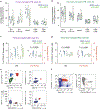In vitro conversion of adult murine endothelial cells to hematopoietic stem cells
- PMID: 30429596
- PMCID: PMC9923715
- DOI: 10.1038/s41596-018-0060-3
In vitro conversion of adult murine endothelial cells to hematopoietic stem cells
Abstract
The ability to generate hematopoietic stem cells (HSCs) in vitro would have an immeasurable impact on many areas of clinical practice, including trauma, cancer, and congenital disease. In this protocol, we describe a stepwise approach that converts adult murine endothelial cells (ECs) to HSCs, termed 'reprogrammed ECs into hematopoietic stem and progenitor cells' (rEC-HSPCs). The conversion, which is achieved without cells transitioning through a pluripotent state, comprises three phases: induction, specification, and expansion. Adult ECs are first isolated from Runx1-IRES-GFP; Rosa26-rtTa mice and maintained in culture under EC growth factor stimulation and Tgfβ inhibition. In the first (induction) phase of conversion (days 0-8), four transcription factors (TFs)-FosB, Gfi1, Runx1, and Spi1 (FGRS)-are expressed transiently, which results in endogenous Runx1 expression. During the second (specification) phase (days 8-20), endogenous Runx1+ FGRS-transduced ECs commit to a hematopoietic fate and no longer require exogenous FGRS expression. Finally, the vascular niche drives robust proliferation of rEC-HSPCs during the expansion phase (days 20-28). The resulting converted cells possess a transcriptomic signature and long-term self-renewal capacity indistinguishable from those of adult HSCs. In this protocol, we also describe functional in vitro and in vivo assays that can be used to demonstrate that rEC-HSPCs are competent for clonal engraftment and possess multi-lineage reconstitution potential, including antigen-dependent adaptive immune function. This approach thus provides a tractable strategy for interrogating the generation of engraftable hematopoietic cells, advancing the mechanistic understanding of hematopoietic development and HSC self-renewal.
Conflict of interest statement
Competing Interests Statement
S.R. is the founder and a non-paid consultant to Angiocrine Bioscience, New York, New York, USA.
Figures




Similar articles
-
Conversion of adult endothelium to immunocompetent haematopoietic stem cells.Nature. 2017 May 25;545(7655):439-445. doi: 10.1038/nature22326. Epub 2017 May 17. Nature. 2017. PMID: 28514438 Free PMC article.
-
Reprogramming human endothelial cells to haematopoietic cells requires vascular induction.Nature. 2014 Jul 17;511(7509):312-8. doi: 10.1038/nature13547. Epub 2014 Jul 2. Nature. 2014. PMID: 25030167 Free PMC article.
-
Endothelial cells provide a niche for placental hematopoietic stem/progenitor cell expansion through broad transcriptomic modification.Stem Cell Res. 2013 Nov;11(3):1074-90. doi: 10.1016/j.scr.2013.07.010. Epub 2013 Aug 9. Stem Cell Res. 2013. PMID: 23978474
-
Hematopoietic stem cell expansion: challenges and opportunities.Ann N Y Acad Sci. 2012 Aug;1266:138-50. doi: 10.1111/j.1749-6632.2012.06549.x. Ann N Y Acad Sci. 2012. PMID: 22901265 Review.
-
Regulation of the hematopoietic stem cell lifecycle by the endothelial niche.Curr Opin Hematol. 2017 Jul;24(4):289-299. doi: 10.1097/MOH.0000000000000350. Curr Opin Hematol. 2017. PMID: 28594660 Free PMC article. Review.
Cited by
-
Harnessing organs-on-a-chip to model tissue regeneration.Cell Stem Cell. 2021 Jun 3;28(6):993-1015. doi: 10.1016/j.stem.2021.05.008. Cell Stem Cell. 2021. PMID: 34087161 Free PMC article. Review.
-
Endothelial Jak3 expression enhances pro-hematopoietic angiocrine function in mice.Commun Biol. 2021 Mar 25;4(1):406. doi: 10.1038/s42003-021-01846-3. Commun Biol. 2021. PMID: 33767339 Free PMC article.
-
Transcriptional activation of regenerative hematopoiesis via microenvironmental sensing.Nat Immunol. 2025 Mar;26(3):378-390. doi: 10.1038/s41590-025-02087-w. Epub 2025 Feb 25. Nat Immunol. 2025. PMID: 40000903
-
Conversion of placental hemogenic endothelial cells to hematopoietic stem and progenitor cells.Cell Discov. 2025 Jan 28;11(1):9. doi: 10.1038/s41421-024-00760-2. Cell Discov. 2025. PMID: 39875377 Free PMC article.
-
Integrated Analyses of Mouse Stem Cell Transcriptomes Provide Clues for Stem Cell Maintenance and Transdifferentiation.Front Genet. 2020 Sep 4;11:563798. doi: 10.3389/fgene.2020.563798. eCollection 2020. Front Genet. 2020. PMID: 33101382 Free PMC article.
References
Publication types
MeSH terms
Substances
Grants and funding
LinkOut - more resources
Full Text Sources
Medical
Molecular Biology Databases
Research Materials
Miscellaneous

